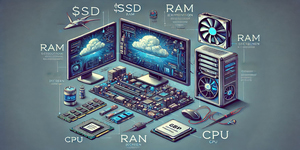At the intersection of human ingenuity and technological advancement lies Artificial Intelligence (AI), a multidisciplinary domain that has captured the imagination of scientists, innovators, and thinkers for decades. AI refers to the creation of machines and systems that exhibit human-like cognitive abilities, enabling them to perceive, reason, learn, and adapt in ways reminiscent of human intelligence. At its heart, AI seeks to replicate, or even transcend, the very essence of human thought processes, ushering in a new era of capabilities and possibilities.
AI encompasses a spectrum of technologies, methodologies, and approaches, each striving to imbue machines with attributes that are quintessentially human. The quest for AI can be traced back to antiquity, where myths and tales of automata that imitated human behaviors ignited visions of creating intelligent machines. Yet, it wasn’t until the mid-20th century that AI emerged as a formal discipline, driven by the pioneering efforts of researchers who aimed to build machines capable of reasoning and problem-solving.
The multifaceted landscape of AI includes various subfields, such as machine learning, natural language processing, computer vision, and robotics. Machine learning stands as a pillar of AI, involving algorithms that allow systems to learn from data, recognize patterns, and improve their performance over time. Natural language processing delves into enabling machines to understand, interpret, and generate human language—a feat that holds the key to bridging the communication gap between humans and machines. Computer vision empowers machines to perceive and interpret visual information from the world around them, laying the foundation for applications like facial recognition and autonomous vehicles. Meanwhile, robotics combines AI and engineering to create physical systems capable of interacting with the environment, from industrial automation to advanced prosthetics.
The journey toward achieving AI is marked by milestones that showcase the ever-evolving capabilities of machines. From the chess-playing prowess of IBM’s Deep Blue to the conversational skills of modern chatbots, AI’s advancements span domains and industries. The introduction of neural networks and deep learning, inspired by the structure of the human brain, has enabled breakthroughs in image recognition, language translation, and even creative endeavors such as art and music generation.
AI’s potential extends beyond replicating human capabilities—it holds the promise of augmenting and amplifying human intelligence. Through collaboration with AI, humans can leverage its computational power to tackle complex problems, make data-driven decisions, and innovate in ways that were once unimaginable. This symbiotic relationship between humans and machines is reshaping industries, from healthcare and finance to entertainment and transportation.
However, the path to AI’s realization is not without challenges. Ethical concerns surrounding bias, transparency, and accountability arise as AI systems influence critical decisions in areas like criminal justice and healthcare. The ethical dimensions also extend to the realm of human employment, as the automation potential of AI prompts discussions about the future of work and the need for reskilling.
In this tutorial, I will tell you what you what is Artificial Intelligence, its historical evolution and key concepts.
Disclaimer: I am not responsible for any damage that may occur during the conversion process.
Historical Evolution of AI
The evolutionary narrative of Artificial Intelligence (AI) is a captivating tale woven with ingenuity, persistence, and paradigm shifts. Its origins can be traced back to antiquity, where ancient civilizations marveled at automata and crafted mechanical devices that aimed to imitate human actions. However, the modern conception of AI took root in the mid-20th century, marked by seminal moments that propelled it from the realm of imagination into reality.
In 1956, a group of visionary researchers, including John McCarthy, coined the term “artificial intelligence” at the Dartmouth Workshop, marking the official beginning of AI as a scientific discipline. This event ignited a surge of enthusiasm that came to be known as the “AI summer.” During this era, AI pioneers harbored grand aspirations of creating machines capable of human-like reasoning and problem-solving. Symbolic AI emerged as the dominant paradigm, wherein computers manipulated symbols to simulate logical reasoning, paving the way for early AI programs like Logic Theorist and General Problem Solver.
However, the initial optimism was met with challenges. Progress often proved slower than anticipated, and AI researchers struggled with limitations in computing power and memory. The first “AI winter” set in during the 1970s, a period marked by reduced funding and skepticism about AI’s feasibility. Despite setbacks, research continued, and the advent of expert systems in the 1980s rekindled interest. Expert systems, rule-based programs that emulated human expertise in specific domains, found applications in areas like medical diagnosis and oil exploration.
The resurgence of AI in the 1980s was followed by another AI winter in the late 1980s and early 1990s. It was clear that achieving human-level intelligence through symbolic reasoning alone was an arduous task. However, a seismic shift occurred in the 1990s with the emergence of machine learning approaches that learned from data. Machine learning opened a new avenue, enabling systems to improve their performance through experience.
The late 1990s and early 2000s saw AI applications enter the mainstream, with technologies like speech recognition and image processing making significant strides. But it was the rise of neural networks and deep learning in the 2010s that truly revolutionized AI. These approaches, inspired by the human brain’s neural connections, demonstrated unprecedented capabilities in image recognition, natural language processing, and game playing.
Today, AI is ubiquitous, powering virtual assistants, autonomous vehicles, and advanced medical diagnostics. The evolution of AI is a testament to human perseverance and innovation, reflecting the fusion of centuries-old fascination with automation and cutting-edge technological breakthroughs. As AI continues to shape our world, its history serves as a reminder of how the convergence of human creativity and computational power can redefine the boundaries of possibility.
Understanding Key AI Concepts
-
Machine Learning and Deep Learning:
In the ever-evolving landscape of Artificial Intelligence (AI), Machine Learning (ML) and Deep Learning (DL) stand as two cornerstones that have redefined how machines understand and interact with the world. These paradigms, rooted in the principles of data-driven learning and neural network architecture, have catalyzed breakthroughs across a myriad of domains, reshaping industries and revolutionizing human-computer interactions.
Machine Learning encompasses a range of techniques that empower machines to learn from data and improve their performance over time without explicit programming. At its core, ML relies on algorithms that discern patterns, relationships, and anomalies within data, enabling systems to make predictions, classifications, and decisions based on learned insights. Supervised learning, unsupervised learning, and reinforcement learning are key paradigms within ML. Supervised learning involves training models on labeled data to predict outcomes, unsupervised learning identifies patterns in unlabeled data, while reinforcement learning guides systems through trial-and-error interactions to optimize actions in dynamic environments.
Deep Learning, a subset of ML, has garnered significant attention for its ability to tackle complex tasks that were once considered insurmountable for computers. Characterized by the use of artificial neural networks with multiple layers (deep neural networks), DL excels at feature extraction and representation learning. This hierarchical structure enables DL models to automatically learn intricate and abstract features from raw data, making it particularly potent in tasks such as image and speech recognition. Convolutional Neural Networks (CNNs) dominate image analysis, while Recurrent Neural Networks (RNNs) are adept at processing sequences, making them invaluable for natural language processing.
DL’s success hinges on its capacity to leverage massive datasets and immense computational power. Advances in hardware, coupled with the availability of big data, have fueled DL’s rapid progress. Notable examples include AlphaGo’s historic victory against a world champion Go player, self-driving cars navigating complex environments, and real-time language translation tools that bridge linguistic barriers.
However, these advancements do not come without challenges. The ‘black box’ nature of deep neural networks raises questions about interpretability and accountability. Moreover, the voracious appetite for data and computing resources poses hurdles for practical deployment, especially in resource-constrained environments.
-
Artificial Neural Networks:
In the realm of Artificial Intelligence (AI), Artificial Neural Networks (ANNs) stand as a technological marvel that draws inspiration from the intricate workings of the human brain. These networks, designed to replicate the brain’s neural connections, have unlocked unprecedented capabilities, propelling AI into realms that were once the domain of science fiction.
At its core, an ANN is a computational model composed of interconnected nodes, or artificial neurons, organized into layers. These nodes process and transmit information, much like neurons in the human brain. The fundamental building block of an ANN is the perceptron, an abstraction of a biological neuron. Multiple perceptrons are organized into layers: input, hidden, and output. The connections, or weights, between neurons are adjusted during training to optimize the network’s performance.
One of the hallmark features of ANNs is their ability to learn from data. This learning occurs through a process called training, where the network is exposed to a large dataset with corresponding labels or outcomes. Through iterative adjustments of weights based on the discrepancies between predicted and actual outputs, the network hones its ability to generalize patterns within the data. This process, known as backpropagation, exemplifies the network’s capacity to adapt and improve its performance over time.
The versatility of ANNs is exemplified by their diverse architectures. Feedforward Neural Networks are the simplest form, with data flowing in a single direction, from input to output layers. More complex architectures include Convolutional Neural Networks (CNNs), tailored for tasks like image recognition by using convolutional and pooling layers to extract and process features. Recurrent Neural Networks (RNNs), on the other hand, excel at processing sequences of data, making them ideal for tasks such as language processing and time series prediction.
However, the increasing complexity of ANNs has led to challenges in interpretability and efficiency. Deep neural networks with numerous layers can be perceived as ‘black boxes’, making it challenging to understand how they arrive at their decisions. Additionally, training deep networks requires substantial computational power, and there is a growing emphasis on developing techniques that streamline the learning process and enhance efficiency.
-
Natural Language Processing (NLP):
In the grand tapestry of Artificial Intelligence (AI), Natural Language Processing (NLP) emerges as a vibrant thread that weaves together the complexities of human communication and the computational prowess of machines. NLP encompasses the study and development of algorithms that empower machines to understand, interpret, and generate human language in ways that bridge the gap between human cognition and machine functionality.
At its essence, NLP strives to enable computers to interact with humans in a manner that is intuitive and conversational. This interaction extends beyond mere syntax and grammar; NLP seeks to imbue machines with an understanding of context, semantics, and even sentiment embedded within language. Achieving this level of sophistication involves overcoming a myriad of challenges, ranging from word ambiguity and cultural nuances to idiomatic expressions and the fluidity of human speech.
The journey of NLP begins with text analysis, wherein machines break down language into its constituent parts—words, phrases, and sentences. Techniques like tokenization and part-of-speech tagging help identify linguistic elements, enabling machines to grasp the structure of language. But NLP’s true power lies in its ability to comprehend the nuances of human communication. Techniques such as named entity recognition identify entities like names of people, places, and organizations, while sentiment analysis gauges emotional tone to discern attitudes and feelings expressed in text.
The development of NLP models is fueled by an abundant resource: text data. Large corpora of text, coupled with the advent of deep learning, have catalyzed remarkable advancements. Word embeddings capture semantic relationships between words, allowing machines to understand the meaning behind words based on their context. Recurrent Neural Networks (RNNs) and Transformers have revolutionized sequence-to-sequence tasks, like language translation and text summarization.
However, NLP is not without its challenges. Language is rife with ambiguity, and understanding context remains an intricate puzzle. Additionally, ethical considerations such as bias in training data and the potential misuse of NLP technologies underscore the importance of responsible development and deployment.
In the grand scheme of AI’s evolution, NLP stands as a bridge—a conduit that enables machines to traverse the intricate landscape of human communication. From chatbots engaging in meaningful conversations to language translation tools erasing linguistic barriers, NLP’s impact is both profound and pervasive. As NLP continues to unravel the nuances of language, it lays the foundation for a future where human-computer interactions are not just functional, but truly intuitive and empathetic.







